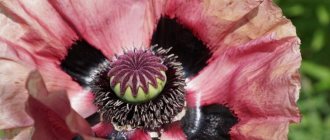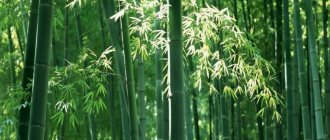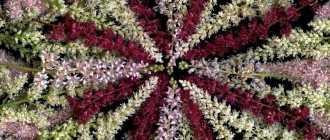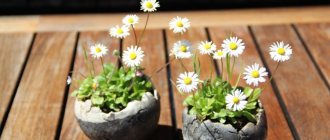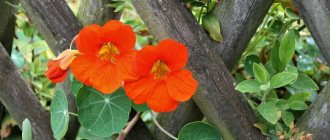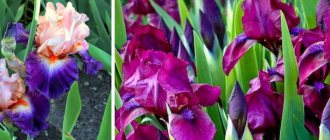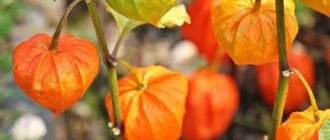Home » Landscape design » Lianas, Bushes and Trees » Conifers
Olga Polyakova 03/24/2020
11593 Views 1 comment
Thuja occidentalis is a coniferous plant native to the shores of the Great Lakes of the North American continent. In their natural habitat, adult thujas reach gigantic sizes - up to 40 meters in height, and their crowns have more than 30 m in diameter.
However, most of us know this plant as an ornamental tree or shrub used to decorate our garden plots. The plant is very popular among owners of private houses, so many ways to use western thuja in landscape design are described.
Description of the western thuja
This is a slowly growing tree, reaching a height of 15-20 m, although taller specimens are also found in nature, but this is already rare. The crown of the western thuja is pyramidal or ovoid, while that of the original species is rather spreading. The root system is compact.
The bark at a young age is brick-brown, smooth, over time it becomes gray-brown; in a tree with more than ten years of history, the bark on the trunk has deep longitudinal cracks and is fibrous.
The needles of the thuja are scaly, green and very small, 2-4 mm long, covering the branches like scales. The lifespan of the foliage is a maximum of 2-3 years, then it falls off, but not one at a time, but in small branches, the crown is renewed gradually and imperceptibly. By winter, the needles discolor to yellowish-green or brown. The concept of “evergreen plant” for thuja is relative; if spruce or pine do not change the shade of their needles at all in winter, then most varieties of western thuja paint the garden yellow-brownish or light green.
The flowers are not decorative - monoecious, apical, solitary. The cones are also small, about 1 cm long, ovoid in shape. Each cone contains two yellow winged seeds.
The wood when cut is reddish in color, often interspersed with brown, yellow and red veins. The wood is soft and durable, does not contain resin, does not rot and could be an excellent furniture material, but is not widely used - this is hampered by the too slow growth of mass and the fibrousness of the bark.
Peculiarities
Thuja is very popular not only in private gardens, but is also widely used for urban landscaping, since the plant is extremely unpretentious to the ecology of the city: it tolerates gas pollution, dust and smoke well. It takes root easily after transplantation, lends itself well to pruning and shearing; some varieties do not require shape correction at all - they grow on their own in a pyramid, ball or cone. In addition, the western thuja and its varieties are winter-hardy (frost hardiness zones from 2b to 8b, this is approximately down to minus 36°C in winter without shelter).
Trimming
Thuja occidentalis is not at all afraid of pruning, but there are a few simple rules to know that will help you keep the plant in its best shape. The crown of each of the decorative varieties of thuja takes on a certain geometric shape in the process of growth: there is a spherical thuja, there is a pyramidal, ovoid and columnar. Based on this, there is no particular need to shape the tree, unless you decide to give the thuja a shape that is unusual for the variety. However, sanitary cleaning of the crown must be done in any case. What are the rules for pruning thuja occidentalis?
You can trim the plant in early spring, summer and autumn in cloudy weather, since the sun's rays dry out the needles damaged during cutting.
Any pruning, including formative pruning, must begin with the removal of diseased and dried branches, after which the plant must be treated with a fungicide.
There is no need to treat cuts on thuja occidentalis branches with garden varnish.
Varieties and varieties of thuja occidentalis
Western thuja has several decorative forms:
- weeping
- columnar (pyramidal)
- hemisphere
- spherical
According to the color of foliage (needles) of the variety:
- variegated (several color variations)
- with green leaves
By tallness:
- full-grown from 5 m or more
- semi-dwarf from 3 to 5 m
- dwarf – mature trees up to 3 m
- miniature – less than 3 m tall
In terms of frost resistance: there are varieties that easily tolerate winters in central Russia, and there are varieties that require mandatory shelter.
Here are some frost-resistant ones:
- Danica (Danica) is a miniature variety up to 60 cm or slightly higher in height, spherical in shape, winter hardiness - climate zone 3.
- Globosa is a spherical miniature thuja, an adult no more than 2 m, grows very slowly, winter hardiness - climate zone 3.
- Golden Globe - semi-dwarf spherical, slow growth rate, very frost-resistant - climate zone 2b.
- Wagneri - narrow-conical, semi-dwarf (up to 3.5 m), fast-growing, winter hardiness - climate zone 4.
- Woodwardii ('Woodwardii) - semi-dwarf, wide-rounded form, grows slowly, winter hardiness - climate zone 4.
- Hoseri - spherical, fast-growing, up to 2 meters high, winter hardiness - climate zone 3.
- Brabant - conical, fast-growing, the variety is similar to Smaragd, but the growth rate is 2-3 times higher, winter hardiness - climate zone 3.
- Sunkist - conical thuja of semi-dwarf growth, grows slowly, very frost-resistant - climate zone 2b.
- Tiny Tim is a miniature variety of thuja, no more than 1 m high, spherical in shape, grows slowly, winter hardiness - climate zone 3.
- Holmstrup is a conical semi-dwarf variety, grows slowly, winter hardiness - climate zone 3.
- Smaragd is a columnar, slow-growing variety, 3-5 m high - average frost resistance - if all the above mentioned varieties can be grown in the conditions of Siberia and the Urals, then Smaragd freezes at temperatures below minus 25-26.
When choosing a variety, consider not only its size, shape and frost resistance, but also its general unpretentiousness. Some do not tolerate shade, even light partial shade, others do not tolerate long thaws in winter (with sudden temperature changes), as this provokes early sap flow. Some varieties require little to no pruning, while others require systematic pruning. There are varieties that are extremely sensitive to compaction of the soil surface; they do not grow on pure loam; annual loosening and mulching are required.
Golden Globe
Thuja occidentalis variety Golden Globe has a spherical crown shape. The height of an adult bush is 80 centimeters. The average annual growth is 10 centimeters.
The needles are loose, golden-yellow in color, becoming orange in autumn.
Landing
If the planting is not done correctly, the Thuja Golden may lose its beauty. Therefore, it is important to do this procedure correctly, taking into account the characteristics of this variety. So:
- This variety loves sunny places or light partial shade.
- Grows and develops well on fertile loams. Preferably without stagnant water.
- Organic and mineral fertilizers should be added to the planting mixture.
- It is necessary to take into account that the root collar must be level with the soil.
Care
Thuja occidentalis Golden needs more frequent watering than its relatives. Receives crown sprinkling well. It also tolerates haircuts well, and subsequently grows even better.
Widely used in decorating low-rise and border hedges. It looks great not only in single plantings, but also in entire compositions.
Thuja occidentalis - a place in the garden
Western thuja varieties are quite diverse not only in appearance, but also in needs. Among them there are varieties that are tolerant to the amount of sun, but most prefer to grow in full sun if possible.
In shady places, the crown forms loose, sometimes one-sided (if there is serious shading on one side).
In places where there is no sun, it is better to avoid growing thujas - they will not only be very retarded in growth, but also the risk of various fungal infections increases.
If you have a close location of groundwater (1-1.5 m), it is permissible to plant conifers only on an artificial hill - an artificial hill at least half a meter high.
Usage
The popularity of thuja is understandable: its variety and shape diversity allows it to be used in landscape compositions of any style. Having an attractive appearance, this breed is unpretentious, tolerates urban conditions well, is very frost-resistant, and lends itself well to haircuts. This set of positive qualities is enough to win everyone’s love and respect.
In 1566, his subjects from distant America brought the richest gifts to the French king: gold, clothing, Indian arts and crafts, the fruits of strange overseas plants and a slender coniferous tree with unusual scale-like leaves, spreading a pleasant aroma of resin. This exotic plant has taken root well in the climate of France. He tolerated the haircut perfectly, which made it possible to enrich the royal park with a variety of topiary figures. The French king appreciated the new plant and called it the tree of life , because its evergreen, fragrant needles enlivened the garden all year round.
This is how the thuja occidentalis acquired a second home in Europe. This magnificent slender tree, 12–20 m high, has a compact, low-hanging pyramidal crown.
| See also: |
Planting thuja occidentalis
Planting is done in prepared holes, in an area cleared of perennial weeds - select all the rhizomes of nettle, sow thistle and other weeds for digging.
The root system of the western thuja depends on the variety - miniature ones have much less than full-sized or semi-dwarf ones. For example, in a thuja, 3-5 m tall, the roots extend to a depth of about a meter, in a two-meter tall one - 50-60 cm.
To plant a thuja variety that will grow more than 3 m in 10-15 years, you need to prepare a hole measuring one meter by one meter wide and deep if the soil on your site is not suitable in structure. The planting pit provides a supply of food for the first few years.
Setting the stage
Thuja prefers soils that are medium loam, moderately nutritious, not too moisture-intensive and not dry, slightly acidic.
If the soil is heavy clay, light sandy, clean peat, it requires mandatory improvement. Therefore, you need to mix the earth dug out of the hole with other components:
- if the soil is clayey, replace half of the excavated soil with equal parts of peat and sand
- if the soil is sandy, replace half of the excavated soil with equal parts of peat and loam (turf soil)
- if the soil is peaty, replace half of the excavated soil with equal parts of loam (turf soil) and sand
We fill the bottom of the hole with a 10-15 cm layer of crushed stone drainage, then fill it with mixed soil. To plant an acquired plant in a prepared and filled hole, we make a hole 30-40 cm wider and 10-15 cm deeper than the root system of the plant (i.e. we make a hole in a filled hole).
Next, mix the excavated soil in half with humus (manure that has been lying in a heap for 3-4 years) and fill the root system of the plant with this soil.
Acidity and liming
You need to know that nitrogen, potassium and phosphorus, as well as most minor elements (iron, magnesium, sulfur and copper) are most easily absorbed in soils with a pH of 6.0 to 8.0.
For thujas, the optimal acidity is from 6.8 to 7.2, although they tolerate more acidic and alkaline conditions, which is what suppliers of planting material use, stating that thujas grow on any type of soil. This is not so; sooner or later, stunting in growth, browning of needles, and sometimes drying out of branches or the entire plant become noticeable.
If the acidity of the soil in your area is below pH 6.5, they should be neutralized to the desired pH with lime or dolomite flour. Read about how to do this - soil deoxidation.
How to plant
Water the plant before removing it from the shipping pot. Place the thuja removed from the container in the center of the hole, spreading the roots evenly. Then lift the tree so that the root collar is slightly higher (2-3 cm) than the ground level.
Fill in the prepared soil and gently compact the soil, pressing down with your hands, just do not squeeze it close to the trunk. The tree will settle a little along with the ground, and the root collar will be level with the horizon. You cannot bury it - this will lead to rotting.
Now you need to make a “saucer” for watering around the tree - a side of soil in a circle near the trunk, 5-6 cm high, so that when watering the water does not spread far beyond the root system. If the conifer is planted on a slope, the “saucer” needs to be made higher.
It is better to immediately mulch the soil around the thuja with pine bark, wood chips, and straw will do for the first time (not the best option - it lets in weeds and quickly decomposes).
Mulching prevents water from spreading, protects roots from overheating in hot weather, and retains moisture in the soil for several days longer. Considering that thujas do not tolerate drying out, mulching is a necessary measure. But the root collar (10-12 cm in diameter) has a minimum layer - cover the ground no more than 1 cm, or not cover it at all, so that the trunk does not rot or rot if the weather is too wet.
At what distance should thuja be planted?
The planting recommendations that you may be given when purchasing planting material are very contradictory. First of all, you need to decide whether you are planting it in a permanent place or allowing the possibility of transplantation.
In general, thujas tolerate transplantation well, especially if the root system is preserved as much as possible, and the time is suitable for such an operation. But sometimes after a few years it will be technically impossible to transplant the trees to a new location. Therefore, plan your garden design in advance.
The distance between plants should take into account the final size of the variety and the possibility of crown correction by pruning. For example, in some varieties of columnar thujas the diameter at the base of the trunk can be almost 2 m, in others - narrow columnar thujas are no more than a meter. Thujas grow slowly, the average increase in height per year is 10-30 cm, in diameter about 5-10 cm. But you need to imagine the garden in perspective, what it will look like in 10-15 years, because it will be almost impossible to replant a full-grown tree.
If you are planning a hedge, say, from the Brabant variety, which has a crown diameter of an adult plant of about 1.5 m, with a planting frequency in a row: every 50-70 cm (there is such a recommendation), you will have to thin them out after a few years, removing them after one. Such large thujas should be planted at a distance of 80-100 cm.
In addition, you need to consider whether you want to preserve the natural shape of the planted variety - so that the cone (pyramid) is clearly visible or not - when planted densely, the hedge forms a dense green wall, it is impossible to distinguish individual specimens with the eye.
Another factor is the possibility of curly pruning; there should be enough space around the tree or shrub to freely care for it - tying, trimming, treating against diseases and pests.
Notes
- [www.rook.org/earl/bwca/nature/trees/thujaocc.html Trees of the Northwoods. Thuja occidentalis.] (English) (Retrieved July 27, 2009)
- Edward F. Gilman and Dennis G. Watson.
[hort.ufl.edu/trees/THUOCCA.pdf Thuja occidentalis.
White-Cedar.] (English) (pdf). 680 Tree Fact Sheets
(unavailable link -
history
). University of Florida. Retrieved July 27, 2009. [web.archive.org/20080408033913/hort.ufl.edu/trees/THUOCCA.pdf Archived from the original on April 8, 2008]. - [www.usna.usda.gov/Hardzone/hrdzon3.html USDA Plant Hardiness Zones Map] (English). The United States National Arboretum. Retrieved July 27, 2009. [www.webcitation.org/610qApXLI Archived from the original on August 17, 2011].
- ↑ 1 2
[www.botanical.com/botanical/mgmh/c/cedyel41.html Cedar, Yellow] (English).
A Modern Herbal
. botanical.com. Retrieved July 29, 2009. [www.webcitation.org/61AZaYC2c Archived from the original on August 24, 2011]. - (English) [plants.usda.gov/plantguide/doc/cs_thoc2.doc USDA NRCS - Thuja occidentalis - Plant guide] (Accessed July 27, 2009)
- ↑ 123
[flower.onego.ru/conifer/thuja_oc.htm Western thuja]. Encyclopedia of ornamental garden plants. Retrieved July 27, 2009. [www.webcitation.org/61AZb2zuy Archived from the original on August 24, 2011]. - [www.ecosystema.ru/08nature/trees/72.htm Western thuja - Thuja occidentalis L.]. Woody plants of Russia
. Ecological. Retrieved July 27, 2009. [www.webcitation.org/61AZcuOW0 Archived from the original on August 24, 2011]. - William F. Johnston.
[forestry.about.com/library/silvics/blsilthuocc.htm Northern White-Cedar] (English).
Forestry
. About.com. Retrieved August 12, 2009. [www.webcitation.org/61AZeQcRS Archived from the original on August 24, 2011]. - I am submissive.
The trees are around us. - Prague: Artia, 1980. - P. 67. - 188 p. - ↑ 1 2
[www.gardenguides.com/plants/plant.asp?symbol=THOC2 Thuja Occidentalis] (English).
Arborvitae - Plant Information
. GardenGuides.com. Retrieved July 29, 2009. [www.webcitation.org/61AZf2jzP Archived from the original on August 24, 2011]. - ↑ 1 2 3 Marilyn D. Dykstra, M. Sabourin.
[www.uoguelph.ca/pdc/Factsheets/PDFs/006CedarPestsDiseases.PDF Pests and diseases of the eastern white cedar] (English) (pdf).
Pest Diagnostic Clinic Factsheet Archive
. University of Guelph (Canada). Retrieved July 29, 2009. [www.webcitation.org/61AZgLU3X Archived from the original on August 24, 2011]. - Zhuravlev V.V.
Aphids of the genus Cupressobium of Eastern Europe, the Caucasus and Central Asia./ Bulletin of Zoology No. 37(5). — Institute of Zoology named after. I.I. Shmalhausen National Academy of Sciences of Ukraine, 2003, p. 13-30 - ↑ 1 2 James A. Duke.
[www.hort.purdue.edu/newcrop/duke_energy/Thuja_occidentalis.html Thuja occidentalis L.] (English).
Crop Index
. Department of Horticulture and Landscape Architecture at Purdue University (USA). Retrieved July 29, 2009. [www.webcitation.org/61AZglfdC Archived from the original on August 24, 2011]. - [www.thuja.ru/tuja.php Thuja is the tree of life]. The first center of traditional medicine "Thuya". Retrieved July 30, 2009. [www.webcitation.org/61AZhF2td Archived from the original on August 24, 2011].
Caring for thuja occidentalis
Beauty requires effort - it starts with regular watering, especially the first month after planting - overdrying is unacceptable.
Thuja grows well only in fertile and moist soil. Plants growing in a flowerpot or container cannot tolerate drying out at all. It is more difficult to track the loss of moisture in conifers than in deciduous ones - the leaves of conifers hang down like rags, while those of conifers turn yellow and dry out. Therefore, watering in open ground should be regular, when there is no rain, approximately once a week.
It is believed that thujas take watering very well by sprinkling, the water washes away dust from the crown and increases air humidity, but thujas love moist air and naturally grow along the banks and slopes of rivers and reservoirs.
However, during sprinkling, you need to make sure that the water not only drips onto the crown, but also wets the root layer under the trees. If there are signs of a fungal infection on the thuja, try to avoid sprinkling during treatment and carry out regular watering from a watering can.
There are varieties that are completely intolerant of both dryness and low air humidity, for example, Globoza nana (miniature spherical), these are best planted near a garden pond, fountain, or stream.
Soil improvement and fertilizing
After planting, thuya has enough nutrients for several years; as a rule, feeding is not needed for the first two years.
In the future, you can improve the soil structure and fertile soil layer by adding a 7-10 cm layer of compost under the trees, rake off the top layer of soil and replace it with humus, and mulch the top with chopped pine bark.
Some varieties, for example, Columna, are sensitive to compaction of the soil surface, the roots do not have enough oxygen, the plants wither, these necessarily require annual loosening and renewal of mulch.
If there is no cow or horse humus, you can replace it with leaf humus.
As fertilizing, it is advisable to use mainly phosphorus-potassium fertilizers, preferably complex with a set of other minerals, designed specifically for coniferous plants. Usually two feedings per season at the beginning and end of summer are sufficient.
Do not forget that the application of mineral fertilizers reduces the pH, and excessive dosages can burn the roots, which is manifested in the browning of the needles, usually not immediately, but within a month.
Crown inspection
Thuja occidentalis is an evergreen plant, but the renewal of leaves and twigs occurs regularly, as a rule, “leaf fall” occurs in the fall, and since the crown of many varieties is very dense, the process can occur unnoticed by us.
Therefore, do not forget to look inside the crown, move apart the branches and select yellow needles; sometimes they accumulate between the branches near the trunk, collecting in “tangles”.
Trimming
Typically, thujas respond well to pruning, do not get sick, and only become thicker after cutting.
If a variety has a columnar shape, this does not mean that the plant will grow branches with a strict pyramidal geometry; some varieties, such as Smaragd, have a clear outline of the shape, others, such as Brabant, grow shaggy and need constant pruning to form a well-groomed appearance.
In young plants just purchased from a nursery, it is often necessary to reduce the number of leading branches, otherwise the plant grows into two or three trunks (double-vertical) and all decorativeness is lost. If possible, select in advance specimens of columnar thujas with one leader trunk. If there are several of them, leave one, carefully trim the second. The crown will grow over the season.
Trimming the tips of the shoots should be done in the spring, with the opening of the buds and until mid-summer, some varieties, especially fast-growing, spherical or ovoid, need to be pruned twice a season, others, slow-growing ones less often - once in the spring, then the crown grows a little over the summer, and the plants look more natural. You can shorten branches by 1/3 of the length maximum, or less if necessary.
Thuja shelter for the winter
Almost all varieties of western thuja need protection from snow and ice. Their branches grow vertically upward, the snow that has accumulated and frozen into the ice cap presses on them and breaks them out. Therefore, you need to tie the trunks so that the snow flies off without stopping.
The binding should be done with soft material - nylon tights are simply ideal for this role - they do not rot and stretch. You can’t tie the crown too tightly, like Christmas trees before being piled into the truck, otherwise the needles inside will rot.
Small specimens, no more than 1.5 m tall, are best protected not with a harness, but with a hut. Make a tripod from wooden slats and wrap it in burlap or white lutrasil.
It is important to consider the susceptibility of some varieties to sunburn. There are varieties that are very resistant - the same Smaragd, occasionally the tops of the heads can burn, and there are varieties that require shelter for the most dangerous period - from the end of February to April in the form of burlap or a protective screen.
Sometimes thujas do not burn in the sun for only one reason - they are heavily covered with snow, this applies mainly to young plants and low-growing spherical ones, but if the winter turns out to be little snow, they are at risk of sunburn, so focus on the weather and precipitation.
Reproduction of thuja occidentalis
Thuja can be propagated by seeds and vegetatively: by cuttings and layering.
Not all varieties are propagated by seeds, and this is rarely practiced due to the possible loss of varietal qualities; in addition, thuja often produces non-viable seeds that do not sprout. Some varietals, like Danica, are propagated exclusively by cuttings. Others, for example, Vareana, Malonyana, when propagated, give high preservation of varietal characteristics (80-85%).
Thuja seeds ripen by the end of October, by November, they cannot be stored, they quickly lose their germination capacity - immediately send them for stratification for 2-3 months in a cold place (+2-4C) and sow them.
Propagation of cuttings is quite easy if you cut branches for rooting in winter. The optimal time is November, not early autumn, but late, if autumn is long, you can cut it in December, before frost.
Cuttings take root in the warmth of 22-24C, in a room greenhouse, i.e. at high soil moisture.
Alternatively, you can use a zip bag - i.e. a transparent plastic bag with a zipper clip - it is convenient to hang it on the window - can be attached to the glass or frame with tape or on a clothespin.
Technique for rooting thuja cuttings
We prepare the soil: 1 part of leaf soil (leaf humus) and 1 part of coarse river sand, or vermiculite and sand in equal parts. For one cutting you need about half a glass - a glass of substrate. Mix the ingredients and be sure to sterilize in the microwave or oven. Place it in a bag and pour some boiled water over it. The soil for germination should not be too damp, just slightly moist.
We cut the stalk about 15 cm long, preferably with a heel, but do not tear it off (the bark is lifted), but cut it with a sharp knife. You need to remove the lower branches from the cutting and place it in a bag in the soil.
Close the bag tightly and hang it in a bright place - for winter - this is a south window, if the windows are too dark - next to the lamp. It is advisable that the total daylight hours be 12-14 hours.
Since the bag is closed, there is no need to water or spray anything. The roots form within a month. Do not remove the cutting from the bag, observe: as long as the needles are green, everything is fine, wait until the root (it is dark) is visible through the bag, you can take it out and plant it in a pot in a substrate consisting of 2-3 parts of leaf humus, 1 part of coarse river sand.
The pot with the planted thuja should be placed in a transparent bag, sprayed with boiled water and tied. After 2-3 days, open the bag for more and more time - gradually accustom it to lower air humidity.
